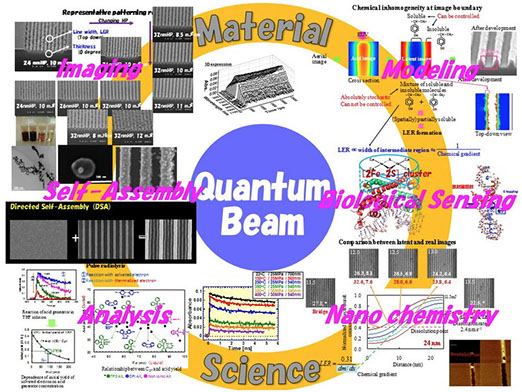

Applied Electrochemistry
Web SiteProfessor KUWABATA Susumu
Associate Professor TSUDA Tetsuya
Associate Professor UEMATSU Taro
We are developing new materials by manipulating surfaces and interfaces with electrochemical methods. Among them, we focus on ionic liquid that consists of salts and has nonvolatile nature. New analytical techniques for surfaces are developed in combination with electron microscopes, and they are utilized in the development of new types of batteries. Another material of interest is semiconductor nanoparticles that are recently known as fluorophores. Efforts to recognize the nature of nanomaterials are made by looking closely at electrons and photons.
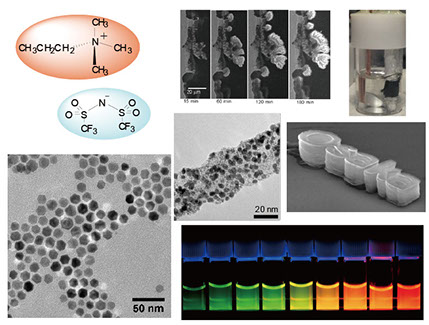
Structural Physical Chemistry
Web SiteAssociate Professor MIZOHATA Eiichi
Our aim is to understand structure/function relationships of proteins. We visualize their three-dimensional structures at an atomic level by X-ray crystallography. To do this, we crystallize proteins and collect X-ray diffraction data from the crystals at SPring-8 or SACLA, and process the data with computers to reveal the electron-density maps. We then speculate the structure/function relationship and design novel molecules that control its function. Development of small-molecule medicines, the 3rd generation antibody drugs, and improvement of global environment and crop productivity are now in study.
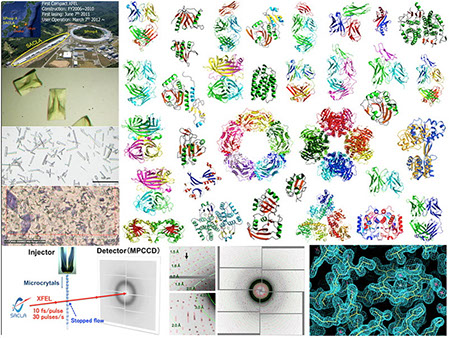
Physical Organic Chemistry
Web SiteProfessor SAKURAI Hidehiro
Associate Professor YAKIYAMA Yumi
Specially Appointed Assistant Professor UETAKE Yuta
RESEARCH OBJECTIVES
We deal with various types of the topics on nanoscience through the physical organic chemistry approach based on the synthetic chemistry.
1) Chemistry of Curved π-Aromatic Molecules
Bowl-shaped π-conjugated compounds including partial structures of the fullerenes, which are called ""buckybowls"", are of importance not only as model compounds of fullerenes but also as their own chemical and physical properties.Very few buckybowls has been achieved for preparation mainly due to their strained structure. We develop the rational route to the various buckybowls with perfect chirality control using the organic synthesis approach, and investigate their physical properties.
2) Chemistry of Metal Nanocluster Catalyst
We also investigate to develop novel catalytic properties of metal nanoclusters. We focus on the following projects: Preparation of size-selective gold and gold-based alloy nanoclusters supported by hydrophilic polymers and its catalytic activity: Development of designer metal nanocluster catalyst using the highly-functionalized protective polymers.
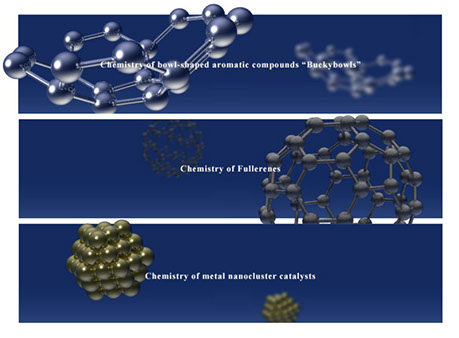
Structural Organic Chemistry
Web SiteProfessor HAYASHI Takashi
Associate Professor ONODA Akira
Assistant Professor OOHORA Koji
We focus on unique relationships between structures and reactivities in various kinds of molecules, including organic molecules, metal complexes and biomolecules. Our research subjects are (1) modification of hemoproteins to enhance their catalytic activities; (2) molecular design and construction of new biohybrid catalysts prepared by incorporation of organometallic species into a protein matrices; (3) construction of hemoprotein assemblies to generate new bionanomaterials; (4) attachment of a redox active protein onto metal or carbon material surfaces; and (5) preparation and characterization of new artificial porphyrinoids with a tetrapyrrole framework.
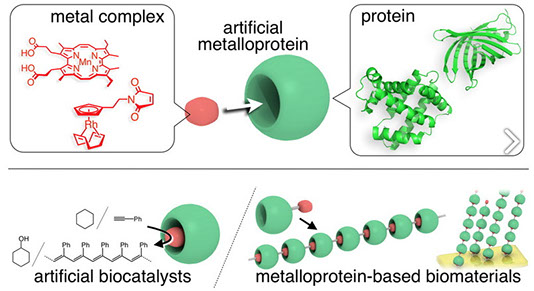
Synthetic Organic Chemistry
Web SiteProfessor MINAKATA Satoshi
Associate Professor TAKEDA Youhei
Assistant Professor KIYOKAWA Kensuke
Research in our group seeks to bring the experience and tactics of strategies of organic methodology development based on synthesis of potential molecules. Especially, our interests are focused on efficient, selective, and environmentally benign methodologies for synthesis of valuable molecules. The new methods have been developed for the synthesis of useful molecules as building blocks for organic synthesis, fullerene derivatives directing toward functional materials, and natural products.
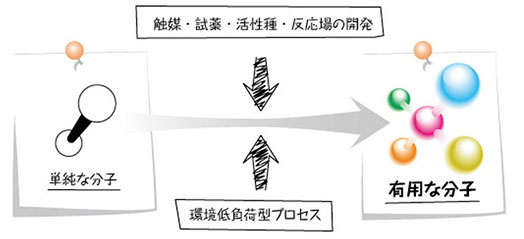
Inorganic Materials Chemistry
Web SiteProfessor IMANAKA Nobuhito
Associate Professor TAMURA Shinji
Assistant Professor NUNOTANI Naoyoshi
We have been developing various kinds of inorganic materials which can be applicable to the solid electrolytes, gas sensors, environmental catalysts, inorganic pigments, phosphors, etc. Until now, we have succeeded in developing the unique materials such as tri- or tetravalent cation conducting solids, extraordinary low-temperature operative environmental catalysts compared to the conventional ones, environmentally friendly pigments showing high color hue.
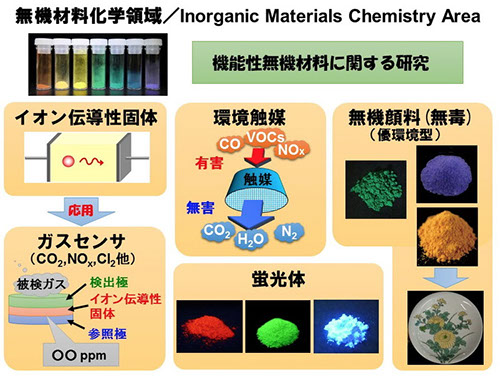
Polymer Materials Chemistry
Web SiteProfessor UYAMA Hiroshi
Associate Professor ASOH Taka-aki
Polymer materials chemistry area deals with new functional polymeric materials on the basis of our original designs and syntheses. We have developed a new fabrication method of nanoporous polymer monoliths and their applications in medical, environmental, and energy fields, a new class of biomass plastics from renewable resources including cellulose and plant oils, and self-assembled prodrug nanoparticles for delivery of bioactive agents, especially bioactive gases.
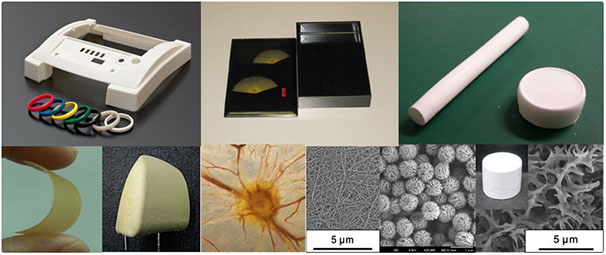
Condensed Matter Physical Chemistry
Web SiteProfessor SAEKI Akinori
Our research targets are mainly (1) formation of hierarchical nanostructure of soft materials such as polymer, molecule, and organic-inorganic hybrid materials, (2) development of novel measurement technique, and (3) design and synthesis of conjugated materials having optical, electrical, and magnetic response towards application such as organic photovoltaics and transistors. These materials are utilized in nano-structuring and functionalization, which are characterized at single molecular level.
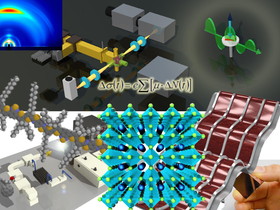
Advanced Materials Chemistry
Web SiteProfessor MACHIDA Ken-ichi
Permanent magnets, phosphors, inorganic materials like ceramics, and so on were studied on the basis of inorganic material chemistry.
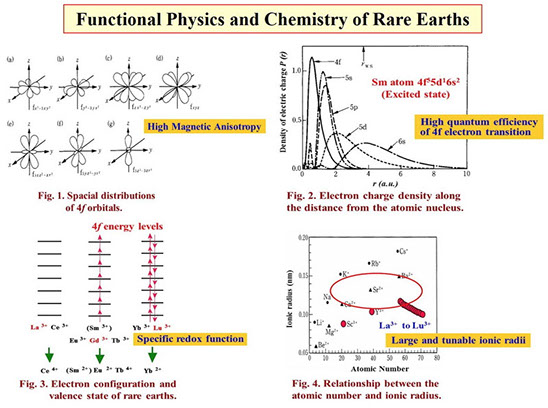
Department of Functionalized Natural Materials
Web SiteProfessor NOGI Masaya
Associate Professor KOGA Hirotaka
Assistant Professor UETANI Kojiro
Cellulose is the most common and abundant bioresources, mainly originating from higher plants. We have successfully extracted cellulose nanofibers with widths of 4-15 nm from wood pulps, and have developed cellulose nanofiber-based materials, such as transparent paper, especially for electronic applications.

Department of Beam Materials Science
Web SiteProfessor KOZAWA Takahiro
Associate Professor MUROYA Yusa
Assistant Professor OKAMOTO Kazumasa
The industrial application of quantum beam will rapidly expand in the field such as high-volume production of semiconductor devices. Cancer therapy using ionizing radiation has also attracted much attention. In Department of Beam Materials Science, the radiation-induced chemical reaction and reaction field have been investigated using state-of-the-art quantum beam (electron, extreme ultraviolet radiation, laser, synchrotron radiation, X-ray, gamma-ray, ion beam). We have studied the chemical reaction system from the energy deposition on materials to the expression of material function. On the basis of these studies, we have designed a noble chemical reaction system.
